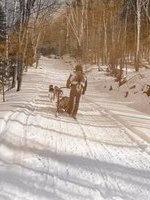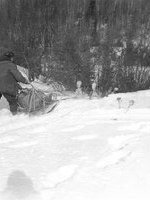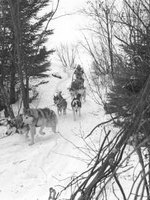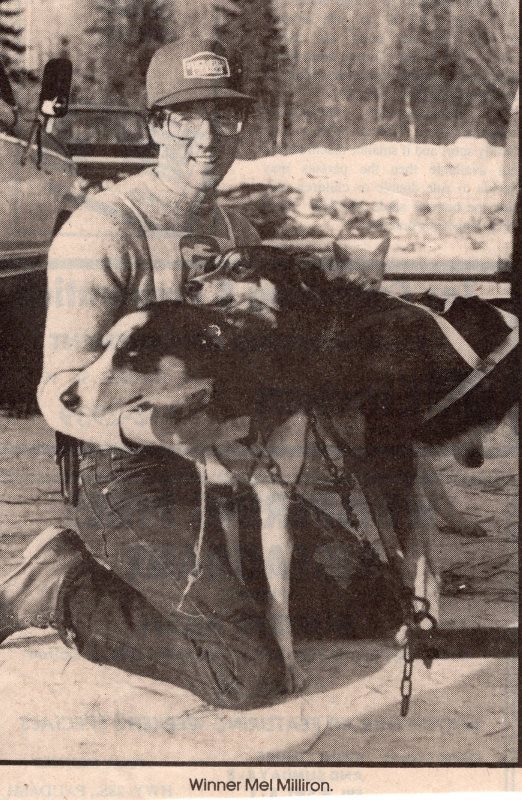BANCROFT SLED DOG RACING by B.M. 1988
What do the Bear Grease, the Iditarod and the Bancroft International have in common? How did diaper rash prevent a competitor from finishing his race? Read on if you care to know.
On Saturday, February 21, the 5th Annual Middle Distance Bancroft sled dog race took place. The course, approximately 55 miles, began and ended at the Bancroft Fish & Game Protective Association’s clubhouse; the trail essentially the same as last year.
The start this year was more dramatic. Two teams at a time lined up – “5,4,3,2,1 – GO!” And the race was on, two teams lunging ahead, each following a parallel path. Where the two trails merged an official stood and pointed to the leading team. That team won first rights to the single lane track. The slower team ceded the right of way. It appeared to run without incident and the drivers, like their dogs, were more ‘pumped up’ at the start. For spectators it was highly exciting to see two teams leaving the starting gate, like high energy dragsters. Two teams racing for the horizon. Going all out. Full bore.
Early in the day the trail was fast and slick. At one point where the trail suddenly dipped to a pond, just before the rail bed, several drivers took a spill, some dragged behind their sleds until they could regain their feet. The dogs stop for noone. Fall off and you are quickly abandoned!

There is a lot of skill to driving a team. Good balance is essential as is a strong, flexible sled. The driver must have a feel for the trail, in essence becoming one with his team to go with the flow. Of course the dogs need to be well trained. Good lead dogs respond to “Haw” (left); “Gee” (right); “Whoa”; “Get up”; “Straight ahead”; or whatever commands the driver has taught. To pass a team yell “Trail” and that team must pull over and stop until passed. One team, in need or more training, would turn and attack any passing team. Intimidating.
Sun worshippers were in their glory. Not so much the teams and drivers, aka mushers. Sunny conditions translated into too much warmth for racing (many practice after sundown in colder temps) and slushy tracks meaning harder slogging. Yet Mel Milliron (mill-iron) of Warren, Ohio, beat his last year’s time with a clocking of 4 hours, 13 minutes, and 44 seconds to win the trophy for a second year in a row. Milliron beat Bob Allen of Reaboro (near Peterboro, Ont.) by less than two minutes.
And, Milliron raced with just 5 dogs as Number 6 was too stiff to run. Allen, who admits that he, himself “couldn’t run across the road”, claims that he saw “Milliron pick up his sled in a Pennsylvania race and run with it under his arm.” Milliron added that he runs up the hills and pumps the rest of the time. That gives him a major advantage.
Each competitor must carry the mandatory survival equipment lest s/he be forced to spend an unanticipated night camping under the stars. Snowshoes, axe, dog and people rations are among the requirements. Race officials check these before and after the race. Officials also mark the dogs to prevent anyone from exchanging a tired pooch for a rested one. Tired dogs get to ride in the sled.
The Bancroft race has a tradition of attracting its share of interesting competitors. This year was no exception. Take, for example, Ron Lecuyer of Belleville. Last year he underwent by-pass surgery. This year he is on the middle distance racing circuit.
Helmut Bank is listed from Whistler, British Columbia. Turns out he is a bricklayer from Toronto. Then there is Paul Alford who hails from the south part of England. For the past two years he has lived in Philadelphia. Until this race he thought “Canada was flat land”.
Asked how he fared Alford responded “I think I placed in the top 40”. Of 42 teams he actually finished in 36th place. Not bad for his second race. During the Marmora race he had a friend fly in from England to be his dog handler.

Marge O’Rourke, from Pennsylvania, finished 28th in her second ever race. She found the Mayo Mountain trails like a roller coaster and “I don’t like roller coasters”. But she loved the trail, the solitude and the scenery. Her brother Kevin finished 5th.
Then there is Bob Hoyte of New York. He has a university degree and delivers the mail. Why?
“I make 50% more money as a mailman and don’t have the hassles of teaching.”
Hoyte finished 7th and had just arrived from competing in the Bear Grease sled dog race in Minnesota. That’s a 373 mile race including a mandatory 8 hour stop over. Two Alaskan teams finished first and second in 63 hours. Hoyte took 72 hours and finished 17th. Just finishing makes him a good ‘musher’. In a normal day he arises at 6:00 a.m., works a 10 hour shift and trains his dogs until 1:00 a.m. Hoyte said that during the Bear Grease Joe Reddington Sr. passed him “like I was standing still”. Reddington is 70.
One year Reddington had an unfortunate accident. While crossing a stream he and his team broke through the ice. As he dried his dogs his pants froze and badly chaffed his legs. Ever since Reddington has been kidded about ‘diaper rash’ stopping him from finishing the race.
Reddington has finished the 1100 mile Iditarod 10 times. But he’s not the oldest competitor to complete the torturous course. Norman Vaughan is trying again this year. He’s 78. The last time he completed the race he was 74. He’s had some tough luck since then. Talk about your ‘lifetime sports’.
Reddington keeps 450 dogs. You read that right; 450! It’s not unusual for a good racer to keep 150. For a mere $25,000 (U.S.) Reddington will rent you a team for the Iditarod. That includes a cabin to stay in. You pay for the dog feed, the $10,000 entry fee…After the race you return the dogs. An Englishman who rented a team revealed that in England it was against the law to make a dog work. Even if it’s in their blood. So, you can’t race them.
Milliron said that in New Jersey a dog weight-pulling event was organized at a shopping mall. The Society for the Prevention of Cruelty to Animals (the S.P.C.A.) raided the event – guns drawn. The S.P.C.A. was going to confiscate the dogs but changed its mind after realizing that it would have a riot on its hands. Instead everyone was told to “go home”. Now, in New Jersey, if you want to organize a dog working event it must be under the auspices of the International Dog Sled Regulations. (Shades of Toronto?)
Want to start a team? Bill Smith of Balsam Lake makes a baby sled, including harness for $100; a hobby sled ($275) and a racing sled ($400). Add $6.50 per dog for ganglines.
Bob Allen advises to start with a couple of older, experienced dogs and to breed your own team with the best dogs available. Allen has an Alaskan husky – stud fee – $400. He says that in the long run it’s worth the investment.
Each year more teams participate and more positive publicity for Bancroft is generated. Of the 42 teams (last year there were 33) 18 came from the U.S. of A. A request has been made that sprint races be added next year. But before that can happen more money, therefore more sponsors, are needed. To date Banner Bits, BRT Trading and the Bancroft Chamber of Commerce sponsor this event. All the monies raised selling buttons … go into the race fund.
Gord Mackey and the Dungannon Volunteers are to be congratulated on another successful race.
The day concluded with the Awards presentation and a dance.

